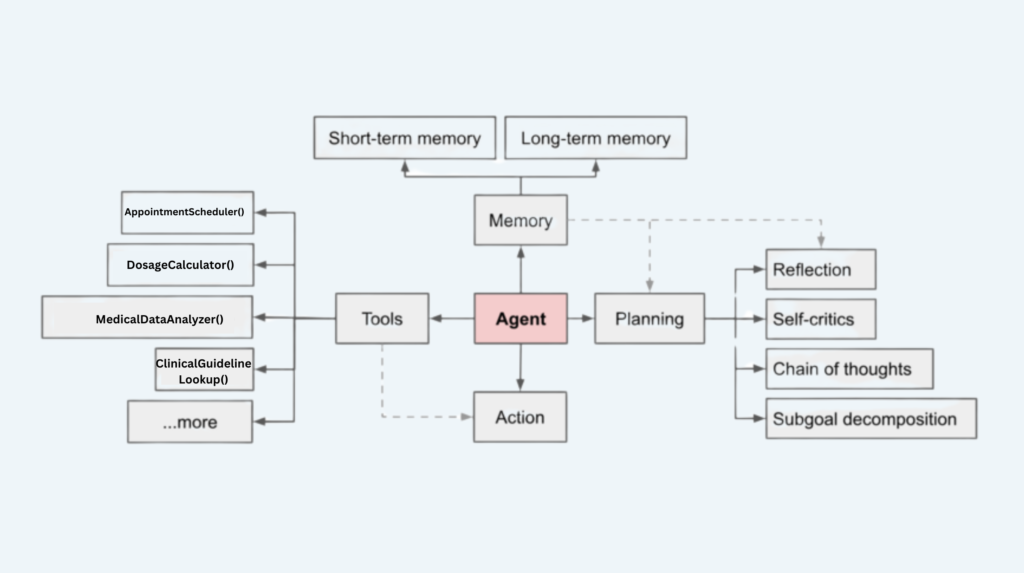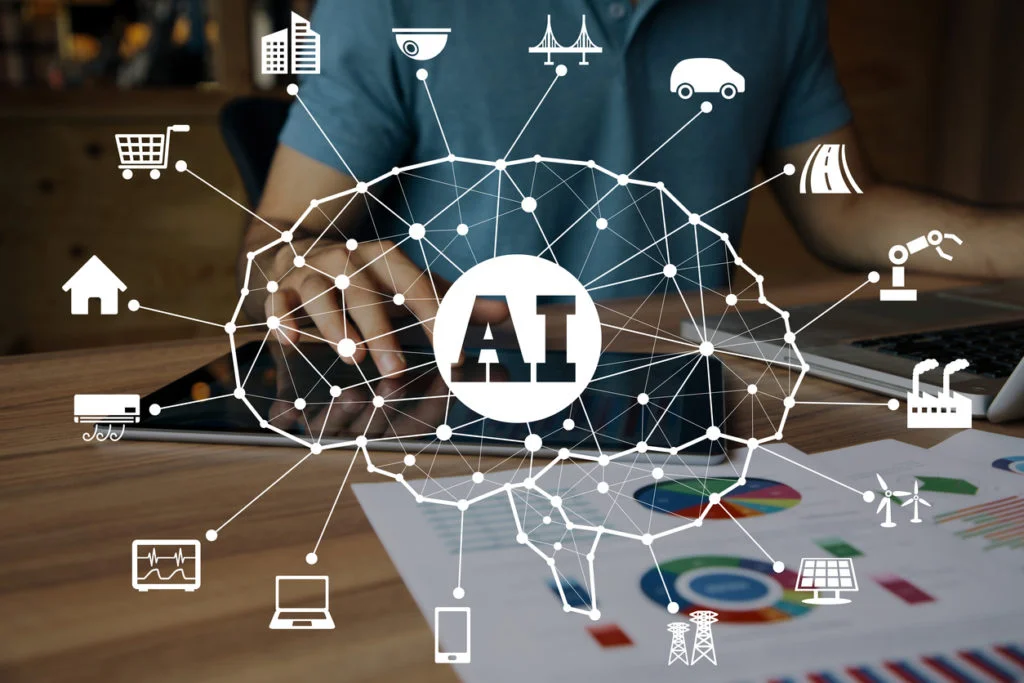AI agents are transforming healthcare by automating tasks, enhancing decision-making, and unlocking new efficiencies across diverse medical domains. These intelligent systems are specifically designed to perform tasks autonomously, enabling healthcare providers to streamline operations, improve patient outcomes, and make data-driven decisions. Research from Frontiers in Artificial Intelligence has shown that AI-driven tools can match or exceed human performance in diagnostic accuracy, highlighting their potential to augment clinical expertise.

From managing complex scheduling needs to facilitating clinical trial participation, AI agents excel in navigating the intricate workflows of healthcare settings. They serve as critical intermediaries, ensuring smoother communication between patients and providers while addressing administrative and clinical challenges.
According to a study published in BMC Health Services Research, implementing AI agents in patient scheduling has reduced wait times substantially, enhancing operational efficiency and patient satisfaction.
The potential of AI agents extends beyond routine tasks. For instance, these agents analyze vast datasets to provide predictive insights, aid in medication compliance, and support pharmacovigilance.
Their ability to sense, process, and act upon data in real-time ensures that they are not only reactive but also proactive—anticipating needs, identifying patterns, and driving healthcare innovation. A report from Cureus highlights how AI-enabled predictive analytics are helping healthcare providers reduce hospital readmission rates by identifying at-risk patients.
This article explores how AI agents optimize healthcare business processes by automating tasks, enhancing decision-making, and improving efficiency. AI agents perform tasks like patient scheduling, claims processing, and clinical decision support by utilizing data processing, automation, and predictive analytics.
They drive cost reduction, improve patient care, and deliver valuable insights. With real-world applications and advancements, AI agents are transforming healthcare, and overcoming challenges like integrating legacy systems and managing stakeholder resistance is key.
Understanding AI Agents in Healthcare
What Are AI Agents?
If you’re looking for answers to “what are AI agents”, then the best way to do that is by understanding autonomous systems. The concept of an autonomous system that perceives and acts has been a central idea in AI research since its early days in the 1950s and 1960s, notably in the works of Allen Newell and Herbert A. Simon on problem-solving programs. However, the structured discussion of “intelligent agents” became more prominent in the 1990s.
Notable contributions to this field include the systematic introduction of agents and environments in Stuart Russell and Peter Norvig’s foundational textbook Artificial Intelligence: A Modern Approach (1995), which remains one of the most widely referenced sources in AI education. Another significant work, Intelligent Agents: Theory and Practice by Michael Wooldridge and Nicholas R. Jennings (1995), provided a comprehensive survey of agent-based computing, covering both theoretical concepts and practical applications.
In broader AI research, terms such as “autonomous agents,” “software agents,” and “multi-agent systems” are frequently used. Noteworthy texts in these areas include M. Wooldridge’s An Introduction to MultiAgent Systems (2009) and Jeffrey M. Bradshaw’s edited collection Software Agents (1997).
While the foundational concepts of AI agents encompass a range of approaches, including rule-based systems and symbolic reasoning, much of the current focus is on LLM-based agents. These agents utilize large language models (LLMs) like GPT, PaLM, and LLaMA, equipped with tools to interact with the environment—often via API calls or plugin integrations. LLM agents can interpret user instructions in natural language, plan a chain of thought, invoke external tools, observe results, and refine actions based on feedback.
Despite the rising prominence of LLM agents, they represent a subset of the broader AI agent concept. Traditional AI agents, for example, often operate in multi-agent environments and use specialized algorithms for tasks like robot soccer or distributed scheduling.
On the other hand, LLM-based agents rely on large language models for decision-making, planning, and action coordination, often generating text to drive their processes. The rise of frameworks like LangChain, Auto-GPT, and BabyAGI has fueled the popularity of these models, but the underlying concept of AI agents continues to evolve, encompassing a variety of methodologies and applications.
How AI Agents Function in Healthcare
AI agents in healthcare play a pivotal role in enhancing efficiency, accuracy, and patient outcomes through several key processes:
- Data Processing: AI agents handle and analyze massive volumes of patient data, clinical information, and medical records in real-time. By using advanced algorithms, these agents can identify patterns and trends across diverse datasets—ranging from medical history and lab results to demographic information. This allows healthcare providers to quickly access comprehensive, up-to-date insights that inform diagnosis, treatment planning, and personalized care strategies.
- Decision Support: Through sophisticated data analysis, AI agents offer decision support tools that assist healthcare professionals in making more accurate, evidence-based decisions. These systems can analyze complex medical data, including imaging results and clinical studies, to suggest potential diagnoses, recommend treatment options, or flag potential risks. AI agents help reduce human error and improve clinical decision-making by providing healthcare providers with actionable, data-backed recommendations.
- Automation: In addition to enhancing clinical decision-making, AI agents automate routine administrative and operational tasks that traditionally require significant time and manual effort. These tasks include appointment scheduling, claims processing, medical billing, and patient follow-ups. By automating these processes, AI agents not only alleviate administrative burdens on healthcare staff but also streamline workflows, reduce operational costs, and minimize the risk of human errors that could lead to delays or miscommunication.
- Predictive Analytics: AI agents are instrumental in predictive analytics, where they analyze historical data to forecast future health risks, treatment outcomes, and patient needs. Using machine learning algorithms, these agents can identify early warning signs of potential health issues—such as chronic conditions, medication adherence issues, or hospital readmissions—enabling healthcare providers to take proactive measures. Predictive analytics enhances personalized care by allowing timely interventions that improve long-term health outcomes, optimize resource allocation, and reduce hospital readmissions.
By integrating these capabilities, AI agents not only enhance the efficiency of healthcare operations but also improve patient care quality, reduce errors, and enable more informed decision-making. This ongoing evolution has the potential to revolutionize healthcare systems by making them more responsive, data-driven, and patient-centered.
Real-World Applications of AI Agents in Healthcare
AI agents are increasingly transforming healthcare by streamlining processes, improving patient outcomes, and reducing operational inefficiencies. Here are some of the key applications:
- Intelligent Scheduling Assistants: AI agents in scheduling systems optimize doctor availability, patient preferences, and resource constraints. These intelligent systems automatically suggest the best appointment times, reschedule in case of conflicts, and enhance patient flow by minimizing wait times. This not only reduces administrative workload but also improves access to care and ensures that patients are seen promptly.
- Clinical Trial Qualification Assistants: AI agents expedite the process of matching patients with appropriate clinical trials. By cross-referencing detailed patient data with trial inclusion and exclusion criteria, these agents help identify the most suitable candidates, speeding up enrollment and ensuring better patient-trial alignment. This reduces delays in clinical research and accelerates the development of new treatments.
- Doctor-Patient Mediation / Proxy Agents: AI agents serve as intermediaries in doctor-patient communications, offering ongoing support and monitoring. These agents can provide instructions, gather patient feedback, and escalate urgent issues to healthcare providers. This ensures continuous patient care, reduces the burden on physicians, and enables more effective management of chronic conditions and follow-ups.
- Medication Management and Compliance: AI agents play a crucial role in supporting medication adherence by sending reminders to patients, tracking their medication schedules, and offering guidance. These agents identify missed doses, flag potential side effects, and alert healthcare providers when necessary. By proactively managing medication regimens, AI agents help prevent complications and ensure better health outcomes.
- Pharmacovigilance Agents: AI agents track real-time patient experiences with medications by analyzing data from public forums, social media, and health reports. These agents can detect adverse drug events (ADEs) and generate immediate alerts for healthcare providers, allowing for swift interventions and enhancing patient safety. This proactive monitoring of drug safety can lead to faster responses to potential health risks.
- e-Detailing (Pharmaceutical Sales/Information): AI agents facilitate on-demand, personalized interactions with physicians, providing them with up-to-date, relevant information about new and existing drugs. These agents support pharmaceutical sales representatives by delivering tailored content, improving their efficiency, and enhancing the quality of information available to healthcare professionals. This, in turn, improves decision-making in treatment planning.
- Decision Support for Clinicians: AI agents assist clinicians in making evidence-based decisions by analyzing complex medical data, including patient histories, test results, and clinical guidelines. These agents provide real-time decision support, offering suggestions for diagnosis, treatment options, and care pathways. By ensuring that clinicians have access to the most relevant and accurate information, AI agents enhance clinical decision-making, reduce errors, and improve patient outcomes.
By integrating AI agents into these healthcare applications, systems can improve operational efficiency, enhance patient care, and reduce costs. As AI technology advances, these applications will expand, fostering further innovation and positive change across the healthcare sector.
Benefits of AI Agents in Healthcare Predictive Analytics
Improved Efficiency: Automating Routine Tasks
One of the primary benefits of AI agents in healthcare is their ability to automate repetitive and time-consuming tasks. Tasks such as appointment scheduling, administrative paperwork, and data entry are often prone to human error and can overwhelm healthcare staff. By automating these processes, AI agents free up time for healthcare professionals, enabling them to focus on more critical activities like patient care.
For example, intelligent scheduling assistants automatically manage appointments, reducing conflicts and optimizing patient flow, while AI-powered decision support systems provide real-time, evidence-based suggestions for clinicians, improving the speed and accuracy of diagnosis. Research from BMJ has shown that automating administrative tasks in healthcare can reduce clinician burnout and improve workflow efficiency substantially.
Cost Reduction: Minimizing Errors and Reducing Labor Costs
AI agents can significantly reduce healthcare costs by minimizing errors and increasing operational efficiency. Automating routine processes reduces the need for manual labor, which in turn lowers administrative overhead. AI agents also help reduce costly mistakes, such as incorrect billing codes or medication errors. For example, AI agents monitoring medication adherence can help prevent missed doses or adverse drug reactions, avoiding potentially costly hospitalizations.
Furthermore, by speeding up processes like clinical trial matching and data analysis, AI agents reduce delays in patient care and research, leading to cost savings across the board. A 2023 study found that AI solutions in clinical trial recruitment led to a significant reduction in recruitment time, translating into significant cost savings for pharmaceutical companies.
Enhanced Patient Care: Personalized Recommendations and Faster Response Times
AI agents play a crucial role in enhancing patient care by delivering personalized recommendations and improving response times. Through predictive analytics, AI agents can identify potential health risks and suggest preventive measures. For example, medication management agents track patients’ medication schedules and provide reminders while also alerting healthcare providers if issues arise, such as missed doses or adverse reactions.
AI agents that monitor rehabilitation progress or manage chronic conditions can offer continuous support, ensuring that patients receive timely interventions when needed, thereby improving health outcomes.
Recent research highlights that AI-powered medication management systems have improved patient adherence by over 60%, leading to better health outcomes in chronic disease management.
Data-Driven Insights: Predictive Analytics and Better Decision-Making
AI agents excel at processing vast amounts of data and providing actionable insights. By analyzing patient records, medical histories, lab results, and even external data sources such as social media and patient forums, AI agents help healthcare providers make more informed decisions.
Predictive analytics, powered by AI, can identify emerging trends and potential risks, allowing healthcare professionals to intervene before issues escalate. For instance, AI agents monitoring patient feedback can detect early signs of medication side effects, triggering alerts to healthcare providers, and enabling them to take prompt action.
These data-driven insights enhance decision-making, improving treatment outcomes and optimized care pathways. A report by the National Institutes of Health found that AI-driven predictive analytics could improve patient outcomes by detecting complications hours earlier than traditional methods.
By integrating AI agents into healthcare systems, organizations can drive efficiency, reduce costs, and provide personalized care that improves patient outcomes. The key to successful implementation lies in the careful design of AI systems that can seamlessly integrate with existing processes, empower healthcare providers, and optimize both clinical and administrative workflows.
Key Steps Involved In Creating AI agents
Creating AI agents is a methodical process that involves designing, developing, and deploying systems capable of intelligent decision-making and task automation. By carefully following these steps, you can build AI agents that deliver consistent results and adapt to complex requirements. Here is an overview of the foundational steps, types of AI agents, and practical AI agents examples to inspire your project.
Step 1: Understand the Concept of AI Agents
AI agents are autonomous systems designed to solve problems, make decisions, or interact with users by analyzing data and using predefined or learned patterns. These agents vary widely in complexity and functionality. Types of AI agents include:
- Reactive Agents: Operate based on current perceptions without relying on memory.
- Goal-Based Agents: Designed to pursue specific objectives while considering potential obstacles.
- Learning Agents: Employ machine learning to adapt and improve over time.
Studying existing AI agents examples in domains such as healthcare, finance, and customer support can provide insight into their potential applications. For instance, AI agents in e-commerce can recommend products based on user behavior, while in customer service, they can resolve queries autonomously.
Understanding the basics ensures you can determine which type of agent suits your needs and its potential use case.
Step 2: Define the Purpose and Use Cases
The foundation of any successful AI project is a clear definition of its purpose. Identify specific goals, target users, and tasks for your AI agent.
- Define Goals: Ask yourself, “What problem should the AI agent solve?” For example, an agent might aim to improve customer engagement or automate complex workflows.
- Evaluate Use Cases: Will your agent be deployed in customer service, supply chain optimization, or healthcare diagnostics? Analyzing AI agents use cases helps identify tools and approaches best suited for your project.
- Scalability Requirements: Consider whether the agent needs to integrate with other systems, operate across different platforms, or support multiple users simultaneously.
For instance, conversational agents designed for e-commerce might leverage AI agents use cases like personalized shopping assistance, while agents in logistics might focus on dynamic inventory management.
Step 3: Choose the Right Framework or Library
Choosing the right framework or library is crucial in shaping your AI agent’s capabilities. Each tool offers unique strengths, and the decision should align with your project goals and the specific types of AI agents you aim to create. Below is a detailed exploration of popular frameworks and their practical applications.
- LangChain: LangChain is a powerful tool for developing AI workflows that involve structured prompts, API integrations, and external data retrieval. Its ability to chain tasks makes it particularly effective for complex, multi-step processes. Whether building conversational agents, document analyzers, or Q&A systems, LangChain simplifies data connection through seamless integration with vector stores, ensuring precise and efficient outcomes.
- LlamaIndex: LlamaIndex is well-suited for handling extensive knowledge bases and unstructured data. It enables efficient document summarization and advanced search capabilities, making it a preferred choice for applications that require managing large datasets. By providing tools to integrate external databases and documents, LlamaIndex helps consolidate scattered information into a unified resource, which is ideal for FAQs, search tasks, and knowledge-intensive workflows.
- Haystack: Haystack stands out for its robust search and retrieval capabilities, making it a reliable choice for intelligent information discovery. With advanced pipelines for tasks like semantic search and question answering, Haystack enables AI agents to deliver accurate results across domains such as healthcare and legal services. Its highly customizable features allow developers to tailor pipelines for unique project needs, ensuring adaptability and precision.
- ChatGPT Plugins and OpenAI Functions: ChatGPT plugins and OpenAI functions empower AI agents to access real-time data and interact with external APIs effectively. These tools are ideal for applications requiring dynamic responses, such as live weather updates, stock market insights, or personalized recommendations. Their flexibility makes them a valuable asset for conversational agents operating in fast-changing environments where up-to-date information is essential.
- Semantic Kernel: Semantic Kernel offers advanced orchestration and planning capabilities, making it highly effective for enterprise-grade solutions. Its seamless integration with Microsoft’s ecosystem allows for efficient workflow automation and multi-step task planning. Organizations can leverage Semantic Kernel to create AI agents tailored to project management, enterprise automation, and complex planning, ensuring high scalability and performance within professional settings.
- Rasa: Rasa is a robust framework for developing advanced conversational agents capable of managing multi-turn dialogues. With its natural language understanding (NLU) and dialogue management features, Rasa supports sophisticated conversational flows. This framework is particularly well-suited for creating customer support bots, interactive FAQ systems, and voice-activated assistants. Its open-source nature ensures extensive customization options while maintaining cost efficiency.
- Hugging Face Transformers: Hugging Face is a versatile library offering a wide array of pre-trained transformer models that can be fine-tuned for specific applications. From chatbots to text classification systems, Hugging Face empowers developers to create AI agents across diverse domains. Its vast ecosystem and active community provide access to cutting-edge advancements, making it a reliable choice for leveraging state-of-the-art AI technology.
- No-Code Platforms: No-code and low-code platforms offer a user-friendly solution for individuals without coding expertise. These platforms enable the creation of AI agents through intuitive drag-and-drop interfaces, simplifying the development process. They are particularly beneficial for startups and small businesses looking to deploy chatbots, automate workflows, or build small-scale applications without investing heavily in technical resources.
- Custom Tooling (Python/Node.js): For projects requiring maximum customization, building AI agents using programming languages like Python or Node.js provides unparalleled flexibility. Custom tooling allows developers to design unique APIs, database integrations, or workflows tailored to specific requirements. Additionally, tools like RabbitMQ or Kafka can be incorporated to create distributed systems capable of real-time processing. Custom solutions are ideal for applications with strict compliance or security requirements, as well as workflows that combine multiple external services. By leveraging this approach, developers gain tight control over data security, caching, and error handling, ensuring the solution is optimized for specialized use cases.
Step 4: Implement Memory and Context Management
Memory and context handling are essential for making AI agents more human-like and context-aware. There are three primary types of memory management in AI agents:
- Short-Term Memory: Used to maintain context during a conversation or task, ensuring coherent interactions.
- Long-Term Memory: Enables agents to store user preferences, historical data, or prior conversations, allowing for personalized experiences.
- Session Management: Helps distinguish between concurrent interactions or tasks, ensuring the agent responds appropriately to different users.
For example, customer service bots can leverage memory to recall past interactions, enhancing the user experience. Tools like LangChain, Rasa, and Semantic Kernel offer robust memory management features, making them essential for building AI agents with advanced context-handling capabilities.
Step 5: Design Reasoning and Planning Capabilities
AI agents often need multi-step reasoning and decision-making to solve complex problems or execute tasks. Incorporating these features enhances the agent’s utility:
- Chain-of-Thought Prompting: Guides the AI agent through intermediate reasoning steps to ensure accuracy.
- Planning and Sequencing: Tools like LangChain and Semantic Kernel allow developers to design agents that can perform a series of actions logically.
- Hallucination Prevention: Structuring workflows and defining boundaries minimizes errors, ensuring reliable results.
For example, agents in the healthcare sector can use reasoning to analyze patient symptoms and recommend appropriate actions, while those in finance might assist with investment planning.
Step 6: Balance Control and Autonomy
AI agents must balance autonomy with human oversight to ensure optimal performance and compliance with safety standards. Key considerations include:
- Autonomous Agents: Handle routine tasks independently, such as sending reminders or updating records.
- Human-in-the-Loop Systems: Incorporate checkpoints where human intervention is required for critical decisions.
- Safety Guardrails: Prevent the agent from executing harmful or unintended actions by defining constraints.
For instance, types of AI agents designed for autonomous customer service might handle FAQs independently while escalating more complex issues to a human representative.
Step 7: Master Prompt Engineering and Instruction Tuning
The quality of prompts and tuning directly impacts the agent’s responses. Here’s how to optimize your agent:
- System Prompts: Define overarching instructions for the agent’s behavior, tone, and scope.
- Few-Shot Learning: Use examples to demonstrate the desired response style and improve performance on niche tasks.
- Instruction Tuning: Fine-tune the model to understand and respond to specific domain terminology.
LangChain and Hugging Face are highly effective for creating custom prompts and tuning models tailored to unique AI agents use cases.
Step 8: Test and Optimize Your AI Agent
Testing is a continuous process to ensure your agent delivers consistent results:
- User Input Testing: Evaluate how well the agent handles different queries, including edge cases.
- Performance Metrics: Track metrics such as accuracy, response time, and user satisfaction.
- Iterative Improvement: Use feedback loops to refine workflows and address any shortcomings.
For example, AI agents examples in the hospitality sector may require frequent testing to handle customer requests accurately, even during high-demand periods.
Step 9: Deploy and Monitor
Deployment marks the culmination of your efforts. Whether hosting on cloud platforms like AWS, using local servers, or integrating into an existing application, monitoring is key to maintaining performance.
- Cloud Deployment: Platforms like Azure or AWS simplify scaling and maintenance.
- Custom APIs: Frameworks like Flask or FastAPI enable seamless integration with external systems.
- Monitoring Tools: Use analytics dashboards to track usage patterns and detect anomalies.
By following these steps and leveraging frameworks like LangChain, Rasa, or Hugging Face, you can successfully build AI agents tailored to your goals. Exploring AI agents use cases and studying AI agents examples ensures your solution is both practical and innovative.
Case Study: Patient Care Process Optimization with AI
In the healthcare sector, operational inefficiencies can severely impact patient care quality, especially in facilities overwhelmed by high patient volumes. This case study showcases how AI agents use cases were leveraged by Achievion to transform a US-based hospital’s patient care processes, enabling improved resource allocation, enhanced treatment success predictions, and overall operational efficiency.
Patient care process optimization with AI
Challenges
The hospital faced an unprecedented patient load—ten times greater than its capacity—creating bottlenecks in patient admissions and treatment planning. Key challenges included:
- Unstructured Data: Patient records stored in the Cerner EMR system were largely in PDF format, making it difficult to extract actionable insights.
- Overwhelmed Resources: With limited operational bandwidth, determining which patients had the highest probability of treatment success became a pressing need.
- Inaccurate Predictions: Lack of predictive tools hindered effective planning for admissions and hospice transitions.
Strategies Used
To address these challenges, Achievion implemented a multi-phased AI-driven solution:
Phase 1: Data Extraction and Preparation
To unlock the potential of the hospital’s unstructured data, Achievion extracted and transformed information using:
- AWS Textract for converting PDF records to text.
- Talend ETL for cleansing and organizing raw data.
- AWS Comprehend Medical for extracting clinical concepts.
For enhanced precision, a custom AI model based on BioBERT was trained on historical medical data to complement the performance of AWS tools.
Phase 2: AI-Powered Patient Admissions Module
With clean and enriched data, Achievion developed a smart admissions system to prioritize patient care efficiently:
- LightGBM Algorithm: Leveraged for its predictive accuracy in identifying patients with the highest likelihood of treatment success.
- Feature Engineering: Included refining critical data points for training robust models.
- User-Friendly Visualization: Built interactive dashboards to display predictions and data trends for healthcare staff.
Phase 3: Treatment Success Prediction
To further enhance decision-making:
- Predictive Analytics: Used LightGBM combined with survival analysis techniques, such as Kaplan-Meier estimators, to model treatment outcomes.
- Hospice Transition Planning: Designed algorithms to determine the optimal timing for hospice care transitions, enabling compassionate and personalized patient management.
- Data-Driven Insights: Visualized results with tools like SHAP and Seaborn for improved interpretability.
Results
The deployment of AI agents delivered significant improvements in hospital operations:
- Streamlined Admissions: The smart admissions module enabled efficient management of high patient volumes without compromising care quality.
- Accurate Predictions: AI-driven tools improved the precision of treatment outcome forecasts, supporting better decision-making.
- Enhanced Resource Allocation: Optimized workflows led to better utilization of staff and equipment.
- Personalized Hospice Care: AI-powered insights improved the timing and quality of end-of-life care decisions.
These advancements not only addressed immediate operational challenges but also demonstrated the transformative potential of AI agents use cases in optimizing healthcare processes.
Lessons Learned
- Data Preparation is Crucial: Clean, structured data forms the foundation for successful AI implementation.
- Customization Enhances Precision: Tailored AI models like BioBERT can significantly boost outcomes in niche applications.
- Collaboration Drives Success: Close coordination between technical teams and healthcare professionals ensures practical, actionable solutions.
This case study highlights how utilizing AI agents use cases can optimize business processes in healthcare, from streamlining patient care to enhancing predictive capabilities. Achievion’s innovative solutions not only resolved a high-capacity hospital’s immediate challenges but also paved the way for scalable improvements across healthcare facilities.
Overcoming Common Barriers
Implementing AI agents in healthcare is transformative but comes with challenges that require strategic solutions. Here, we discuss key barriers and how to overcome them effectively.
Integrating Legacy Systems with AI
Many healthcare facilities rely on older electronic medical records (EMR) and electronic health records (EHR) systems, which can be difficult to integrate with modern AI solutions. These systems often lack standardized APIs, limiting seamless data exchange and real-time updates.
Solutions:
- Standardized Interfaces: Utilizing frameworks like FHIR (Fast Healthcare Interoperability Resources) ensures smoother integration of AI agents with legacy systems.
- Middleware Development: Creating middleware bridges between old and new systems can facilitate data flow without overhauling the existing infrastructure.
- Gradual Transition Plans: Implementing AI modules incrementally allows organizations to test compatibility and make adjustments without disrupting ongoing operations.
Gaining Stakeholder Buy-In and Managing Change Resistance
Introducing AI agents often faces resistance from healthcare providers, administrators, and patients. Concerns about job displacement, mistrust of automated decisions, and the perceived complexity of AI solutions can hinder adoption.
Strategies for Engagement:
- Education and Training: Offer training sessions to clinicians and administrators, highlighting how AI agents can enhance efficiency without replacing human expertise.
- Demonstrating ROI: Share data-backed case studies and pilot results that showcase tangible benefits such as reduced administrative burden and improved patient outcomes.
- Patient-Centric Design: Engage patients through user-friendly interfaces that emphasize empathy and transparency, ensuring a smoother transition to AI-supported care.
Ethical Considerations and Transparency
The use of AI in healthcare raises ethical concerns related to privacy, fairness, and accountability. Without clear guidelines, these issues can erode trust in AI systems.
Ensuring Ethical Implementation:
- Transparency in Decision-Making: AI systems must provide clear explanations for recommendations, enabling healthcare professionals to understand and validate outputs.
- Data Privacy Compliance: Adhering to regulations like HIPAA (U.S.) and GDPR (EU) is essential for safeguarding sensitive patient information. Employ secure data storage and encryption protocols to maintain compliance.
- Fairness and Bias Mitigation: Regular audits of AI models are necessary to identify and address biases that could lead to unequal patient treatment.
- Shared Accountability: Clearly define roles and responsibilities to address liability concerns in scenarios where AI-based decisions lead to adverse outcomes.
By addressing these barriers, organizations can unlock the full potential of AI agents to streamline operations, improve decision-making, and enhance patient care while maintaining trust and ethical standards in healthcare processes.
How Achievion Solutions Can Help You Adopt AI Agents
Achievion Solutions has established itself as a leader in developing customized AI solutions that empower healthcare organizations to optimize processes, improve patient care, and drive operational efficiency. With extensive expertise in AI-powered healthcare technologies, we can help you build AI systems that enhance precision, scalability, and productivity.
Tailored AI Solutions for Healthcare
Achievion is dedicated to delivering AI solutions specifically designed for healthcare organizations, addressing the unique challenges within the sector. By integrating real-time analytics, predictive models, and seamless data systems, Achievion’s AI agents streamline workflows and support better decision-making. Whether optimizing hospital operations or enhancing diagnostic accuracy, Achievion’s solutions are tailored to meet the specific needs of healthcare providers.
For example, Achievion developed an AI-driven heart monitoring system that analyzes real-time data to detect irregularities, improving diagnostics and enabling timely interventions. Additionally, Achievion’s AI solutions have been instrumental in automating patient care processes, resulting in reduced wait times, better resource allocation, and improved patient satisfaction.
Comprehensive Support at Every Stage
Achievion offers end-to-end support to ensure AI solutions are successfully deployed and continuously optimized within your organization. The implementation process is handled seamlessly through four key stages:
- Initial Assessment and Deployment: Achievion begins by analyzing your current healthcare operations and identifying specific areas for improvement. A tailored implementation plan is developed to address these needs, ensuring that AI integration aligns with your operational goals.
- System Integration: Achievion integrates AI agents into your existing infrastructure, prioritizing compatibility and minimizing disruptions. This process includes establishing data pipelines, ensuring cloud infrastructure, and adhering to regulatory standards.
- Scalability and Optimization: AI systems are designed for scalability, allowing healthcare organizations to expand their AI capabilities across departments or facilities. Achievion ensures that systems are continuously monitored and optimized for sustained success.
- Regulatory Compliance: Navigating the complexities of healthcare regulations is a priority. Achievion’s solutions are aligned with global standards, such as HIPAA and FDA compliance, ensuring your AI systems meet necessary regulatory requirements.
Proven Success in AI Healthcare Projects
Achievion’s proven track record demonstrates the tangible benefits of AI implementation in healthcare settings:
- AI-Powered Heart Monitoring Software: Achievion developed an advanced AI system that enables real-time monitoring of cardiac health, improving early detection and providing accurate predictions. This tool empowers healthcare professionals to intervene proactively, enhancing patient outcomes.
- Patient Care Process Optimization: Achievion implemented an AI-driven solution that streamlined hospital operations, reducing inefficiencies and enhancing resource allocation. The results included lower wait times, increased patient satisfaction, and improved workflow management.
- Drug Effectiveness Prediction Software: Achievion’s AI model accurately predicted drug effectiveness and potential side effects, helping healthcare providers make more informed decisions. The software resulted in a 46% reduction in adverse reactions, significantly improving patient safety.
Achievion Solutions is dedicated to helping healthcare organizations harness the power of AI to drive operational transformation. Our team of experts works alongside you to design, implement, and optimize AI agents that meet your specific needs, whether that’s improving diagnostics, enhancing patient engagement, or optimizing business processes.
Contact us today to explore how our AI-powered solutions can revolutionize your healthcare operations. Let’s build a smarter, more efficient healthcare system together.









